Using Schedule J for line 9 tax.
Use Schedule J, Farm Income Averaging, to figure the line 9 tax on Form 8615 if Schedule J is used to figure the tax on the parent's
return. First complete the actual Schedule J for the parent, then use another Schedule J as a worksheet to figure the tax to enter on line
9 of Form 8615. (Do not attach this worksheet to the child's return.)
Complete this worksheet Schedule J as follows.
- On line 1, enter the amount from line 8 of Form 8615.
- On line 2, enter the amount from the parent's Schedule J, line 2.
- Complete line 3 following the Schedule J instructions.
- Complete line 4. If line 8 of Form 8615 includes any net capital gain, use the Capital Gain Tax Worksheet to figure the tax
amount on this line unless the child, parent, or any other child has unrecaptured section 1250 gain, 28% rate gain, qualified 5-year gain,
or an amount on Form 4952, line 4e. In that case, use Schedule D to figure this tax or, if there is unrecaptured section 1250 gain or 28% rate gain,
use the Schedule D Tax Worksheet. Follow the earlier instructions under Using the Capital Gain Tax Worksheet for line 9
tax, Using Schedule D for line 9 tax, or Using the Schedule D Tax Worksheet for line 9 tax, except use the
amount on line 3 of this worksheet (instead of the amount on line 8 of Form 8615) in:
- Item (1) of Using the Capital Gain Tax Worksheet for line 9 tax or Using the Schedule D Tax Worksheet for line 9 tax,
or
- Item (2) of Using Schedule D for line 9 tax.
- On lines 5 through 16, enter the amounts from the parent's Schedule J, lines 5 through 16.
- Complete line 17 following the Schedule J instructions.
- On lines 18 through 21, enter the amounts from the parent's Schedule J, lines 18 through 21.
- Complete line 22 following the Schedule J instructions.
Enter the amount from line 22 of this worksheet Schedule J on line 9 of Form 8615 and check the box on that line.
Line 10 (Parent's Tax)
Enter on line 10 the amount from the parent's Form 1040, line 42; Form 1040A, line 28 (minus any alternative minimum tax); Form 1040EZ, line 10;
TeleFile Tax Record, line K; Form 1040NR, line 40; or Form 1040NR-EZ, line 15. Do not include the tax, if any, from Form 4972 or Form
8814.
Line 11 (Tentative Tax)
Subtract line 10 from line 9 and enter the result on this line. This is the tentative tax.
If line 7 is blank, skip lines 12a and 12b and enter the amount from line 11 on line 13. Also skip the discussion for lines 12a and 12b that
follows.
Lines 12a and 12b (Dividing the Tentative Tax)
If an amount is entered on line 7, divide the tentative tax shown on line 11 among the children according to each child's share of the total net
investment income. This is done on lines 12a, 12b, and 13. Add the amount on line 7 to the amount on line 5 and enter the total on line 12a. Divide
the amount on line 5 by the amount on line 12a and enter the result, as a decimal, on line 12b.
Example.
In the earlier example under Line 7 (Net Investment Income of Other Children), Sharon's Form 8615 shows $1,600 on line 7. The amount
entered on line 12a is $2,400, the total of the amounts on lines 5 and 7 ($800 + $1,600). The decimal on line 12b is .333, figured as follows and
rounded to three places.

formula
Line 13 (Child's Share of Tentative Tax)
If an amount is entered on line 7, multiply line 11 by the decimal on line 12b and enter the result on line 13. This is the child's share of the
tentative tax.
Step 3. Figuring the Child's Tax
The final step in figuring a child's tax using Form 8615 is to determine the larger of:
- The total of:
- The child's share of the tentative tax based on the parent's tax rate, plus
- The tax on the child's taxable income in excess of net investment income, figured at the child's tax rate, or
- The tax on the child's taxable income, figured at the child's tax rate.
This is the child's tax. It is figured on lines 14 through 18 of Form 8615.
Line 14 (Child's Taxable Income in Excess of Net Investment Income)
If lines 4 and 5 of Form 8615 are the same, the child's taxable income does not exceed the child's net investment income. Enter zero on lines 14
and 15, and go to line 16. Also skip the rest of this discussion and the discussion for line 15 that follows.
If lines 4 and 5 are not the same, subtract line 5 from line 4 and enter the result on line 14. Then, before completing line 15, you must determine
the amount of net capital gain, if any, included on line 14.
Net capital gain on line 14.
If the child does not have any net capital gain, the net capital gain included on line 14 is zero. For an explanation of net capital gain, see the
earlier discussion for line 8 of Form 8615.
If the child has net capital gain, the amount included on line 14 is the amount from line A of the child's completed Line 5 Worksheet
minus the amount from the last line of that worksheet. (See the earlier discussion for line 8 of Form 8615.)
Line 15 (Tax on Child's Taxable Income in Excess of Net Investment Income)
Figure the tax on the amount on line 14 using the Tax Table, the Tax Rate Schedules, the Capital Gain Tax Worksheet, the Schedule D
Tax Worksheet, or Schedule D or J (Form 1040), as follows.
- If line 14 does not include any net capital gain, use the Tax Table or Tax Rate Schedules (or Schedule J, if applicable) to
figure this tax.
- If line 14 does include any net capital gain, use the Capital Gain Tax Worksheet to figure this tax unless the child
has unrecaptured section 1250 gain, 28% rate gain, qualified 5-year gain, or an amount on Form 4952, line 4e. In that case, use Schedule D to figure
this tax. (But use Schedule J instead, if it applies.)
Using the Capital Gain Tax Worksheet for line 15 tax.
If you use the Capital Gain Tax Worksheet to figure the line 15 tax on Form 8615, complete that worksheet as follows.
- On line 1, enter the amount from line 14 of Form 8615.
- On line 2, enter the amount of the net capital gain included on line 14 of Form 8615. (See the earlier discussion for line 14.)
- Complete lines 3 through 15 following the worksheet instructions. Use the child's filing status to complete lines 4, 5, and 14.
Enter the amount from line 15 of this Capital Gain Tax Worksheet on line 15 of Form 8615 and check the box on that line. Do not
attach this worksheet to the child's return.
Using Schedule D for line 15 tax.
Use Part IV of Schedule D to figure the line 15 tax on Form 8615 if the child has qualified 5-year gain or an amount on Form 4952, line 4e, and no
unrecaptured section 1250 gain or 28% rate gain. (If the child has unrecaptured section 1250 gain or 28% rate gain, see Using the Schedule D Tax
Worksheet for line 15 tax, next.) If you must use Schedule D, first complete any actual Schedule D required for the child. Then figure the line
15 tax using Part IV of another Schedule D as a worksheet. (Do not attach this worksheet Schedule D to the child's return.)
Complete this worksheet Schedule D as follows.
- On line 19, enter zero.
- On line 20, enter the amount from line 14 of Form 8615.
- On line 21, enter the net capital gain included on line 14 of Form 8615. (See the earlier discussion for line 14.)
- On line 22, enter the amount from line 22 of the child's actual Schedule D.
- Complete lines 23 through 40, following the Schedule D instructions. Use the child's filing status to complete lines 25, 26, and 39. If you
need to complete line 29, enter zero if the child has no qualified 5-year gain (line 8 of the Qualified 5-year Gain Worksheet in the
Schedule D instructions). Otherwise, in the earlier discussion for line 9 of Form 8615, see the Worksheet for Line 29 of Schedule D (Line 9
Tax) or the Worksheet for Line 17 of the Schedule D Tax Worksheet (Line 9 Tax), whichever was used. Subtract line 5 of that worksheet
from line 1 of that worksheet and enter the result on line 29 of this worksheet Schedule D.
Enter the amount from line 40 of this worksheet Schedule D on line 15 of Form 8615.
Using the Schedule D Tax Worksheet for line 15 tax.
Use the Schedule D Tax Worksheet in the Schedule D instructions to figure the line 15 tax on Form 8615 if the child has unrecaptured
section 1250 gain or 28% rate gain. If you must use the Schedule D Tax Worksheet, first complete any Schedule D and any actual
Schedule D Tax Worksheet required for the child. Then figure the line 15 tax using another Schedule D Tax Worksheet.
(Do not attach this Schedule D Tax Worksheet to the child's return.)
Complete this Schedule D Tax Worksheet as follows.
- On line 1, enter the amount from line 14 of Form 8615.
- Leave lines 2 and 3 blank.
- On line 4, enter the net capital gain included on line 14 of Form 8615. (See the earlier discussion for line 14.)
- Leave line 5 blank.
- On line 6, enter zero if the child has no 28% rate gain (line 15 of Schedule D). Otherwise, see the Worksheet for Line 6 of the
Schedule D Tax Worksheet (Line 9 Tax) under Using the Schedule D Tax Worksheet for line 9 tax, earlier. Subtract line 6 of that
worksheet from line 2 of that worksheet, and enter the result on line 6 of this worksheet.
- On line 7, enter zero if the child has no unrecaptured section 1250 gain (line 19 of Schedule D). Otherwise, in the earlier discussion for
line 9 of Form 8615, see the Worksheet for Line 7 of the Schedule D Tax Worksheet (Line 9 Tax). Subtract line 5 of that worksheet from line
1 of that worksheet and enter the result on line 7 of this worksheet.
- Complete lines 8 through 37, following the worksheet instructions. Use the child's filing status to complete lines 11, 15, and 36. If you
need to complete line 17, enter zero if the child has no qualified 5-year gain (line 8 of the Qualified 5-Year Gain Worksheet in the
Schedule D instructions). Otherwise, in the earlier discussion for line 9 of Form 8615, see the Worksheet for Line 17 of the Schedule D Tax
Worksheet (Line 9 Tax). Subtract line 5 of that worksheet from line 1 of that worksheet and enter the result on line 17 of this
worksheet.
Enter the amount from line 37 of this Schedule D Tax Worksheet on line 15 of Form 8615 and check the box on that line.
Using Schedule J for line 15 tax.
If Schedule J applies, use it as a worksheet to figure the tax to enter on line 15 of Form 8615. On line 1 of this worksheet, enter the amount from
line 14 of Form 8615. Complete lines 2 through 22 following the Schedule J instructions. Use the child's filing status to complete lines 4, 8, 12, and
16.
Enter the amount from line 22 of this worksheet Schedule J on line 15 of Form 8615 and check the box on that line. Do not attach this worksheet to
the child's return.
Line 16 Combined Tax
Add lines 13 and 15 and enter the total on line 16. This is the child's tax figured at the parent's rate on net investment income and the child's
rate on other income.
Line 17 (Tax at Child's Rate)
Figure the tax on line 4 (the child's taxable income). Use the Tax Table, the Tax Rate Schedules, the Capital Gain Tax Worksheet, the
Schedule D Tax Worksheet, or the child's actual Schedule D or J, whichever applies. Enter the tax amount on line 17. If it is from the
Capital Gain Tax Worksheet, the Schedule D Tax Worksheet, Schedule D, or Schedule J, check the box on that line.
Line 18 (Tax)
Enter on line 18 the larger of line 16 or line 17. Also enter this amount on the child's Form 1040, line 42; Form 1040A, line 28; or Form 1040NR,
line 40. This is the child's tax.
Alternative Minimum Tax
A child may be subject to alternative minimum tax (AMT) if he or she has certain items given preferential treatment under the tax law. These items
include accelerated depreciation and certain tax-exempt interest income. The AMT may also apply if the child has passive activity losses or certain
distributions from estates or trusts.
For more information on who is liable for AMT and how to figure it, get Form 6251.
Limit on exemption amount.
Ordinarily, single people can subtract a $35,750 exemption amount from their AMT taxable income. However, a child who files Form 8615 has a limited
exemption amount. The child's exemption amount for 2002 is limited to the child's earned income plus $5,500. Figure the child's allowable exemption
amount on the worksheet in the instructions for line 29 of Form 6251.
Illustrated Example
This example shows how to fill out Forms 8615 and 1040A for Sara Brown. It also shows how to use the Capital Gain Tax Worksheet in the
Form 1040A instructions to figure Sara's tax.
John and Laura Brown have one child, Sara. She is 13 and has $2,100 taxable interest and dividend income, $700 capital gain distributions, and
$1,550 earned income. She does not itemize deductions. John and Laura file a joint return with John's name and social security number listed first.
They claim three exemptions, including an exemption for Sara, on their return.
Because she is under age 14 and has more than $1,500 investment income, part of her income may be subject to tax at her parents' rate. A completed
Form 8615 must be attached to her return.
Sara's father, John, fills out Sara's return. He completes her Form 1040A through line 27, then begins completing her Form 8615.
John enters his name and social security number on Sara's Form 8615 because his name and number are listed first on the joint return he and Laura
are filing. He checks the box for married filing jointly.
He enters Sara's investment income, $2,800, on line 1. Sara does not itemize deductions, so John enters $1,500 on line 2. He enters $1,300 ($2,800
- $1,500) on line 3.
Sara's taxable income, as shown on line 27 of her Form 1040A, is $2,550. This is her total income ($4,350) minus her standard deduction ($1,800).
Her standard deduction is limited to the amount of her earned income plus $250. John enters $2,550 on line 4.
John compares lines 3 and 4 and enters the smaller amount, $1,300, on line 5.
John enters $48,000 on line 6. This is the taxable income from line 41 of their joint Form 1040 return. Sara is an only child, so line 7 is blank.
He adds line 5 ($1,300), line 6 ($48,000), and line 7 (blank) and enters $49,300 on line 8.
Because Sara's capital gain distributions are included on line 5, John uses Line 5 Worksheet #1 (in the discussion for line 8, earlier)
to figure out that $325 net capital gain is included on line 5. He completes that worksheet as follows.
| Line 5 Worksheet #1 |
| A. |
Enter the child's net capital gain |
700 |
| B. |
Enter the amount from line 1 of the child's Form 8615 |
2,800 |
| C. |
Divide line A by line B (but do not enter more than 1) |
.25 |
| D. |
Multiply $1,500 by line C |
375 |
| E. |
Net capital gain on line 5. Subtract line D from line A (but do not enter less than zero or more than the amount on line 5 of Form 8615) |
325 |
Therefore, line 8 of Sara's Form 8615 also includes net capital gain of $325. John uses the Capital Gain Tax Worksheet (in the Form
1040A instructions) and follows the instructions under Using the Capital Gain Tax Worksheet for line 9 tax, earlier, to figure the $7,084
tax to enter on line 9 of Sara's Form 8615. He completes that worksheet as shown on Filled-in Capital Gain Tax Worksheet #1.
He enters the tax from his and Laura's Form 1040 ($6,763) on line 10 of Sara's Form 8615, subtracts that amount from the $7,084 on line 9, and
enters the $321 remainder on line 11. Because line 7 is blank, John skips lines 12a and 12b and enters $321 on line 13.
John subtracts line 5 ($1,300) from line 4 ($2,550) and enters the result, $1,250 on line 14. Using the instructions for line 14 earlier, John
subtracts the net capital gain included on line 5 ($325) from Sara's net capital gain ($700) to figure the $375 net capital gain included on line 14.
He uses another Capital Gain Tax Worksheet and follows the instructions under Using the Capital Gain Tax Worksheet for line 15 tax,
earlier, to figure the $126 tax to enter on Form 8615, line 15. He completes that worksheet as shown on Filled-in Capital Gain Tax
Worksheet #2.
John adds lines 13 and 15 of Form 8615 and enters the sum, $447, on line 16. Then he uses another Capital Gain Tax Worksheet to figure
the $256 tax on Sara's $2,550 taxable income to enter on Form 8615, line 17. He completes that worksheet as shown on Filled-in Capital Gain Tax
Worksheet #3.
Finally, John compares lines 16 and 17 and enters the larger amount, $447, on line 18 of Sara's Form 8615. He also enters that amount on line 28 of
Sara's Form 1040A.
John also completes Schedule 1, Form 1040A (not shown) for Sara.
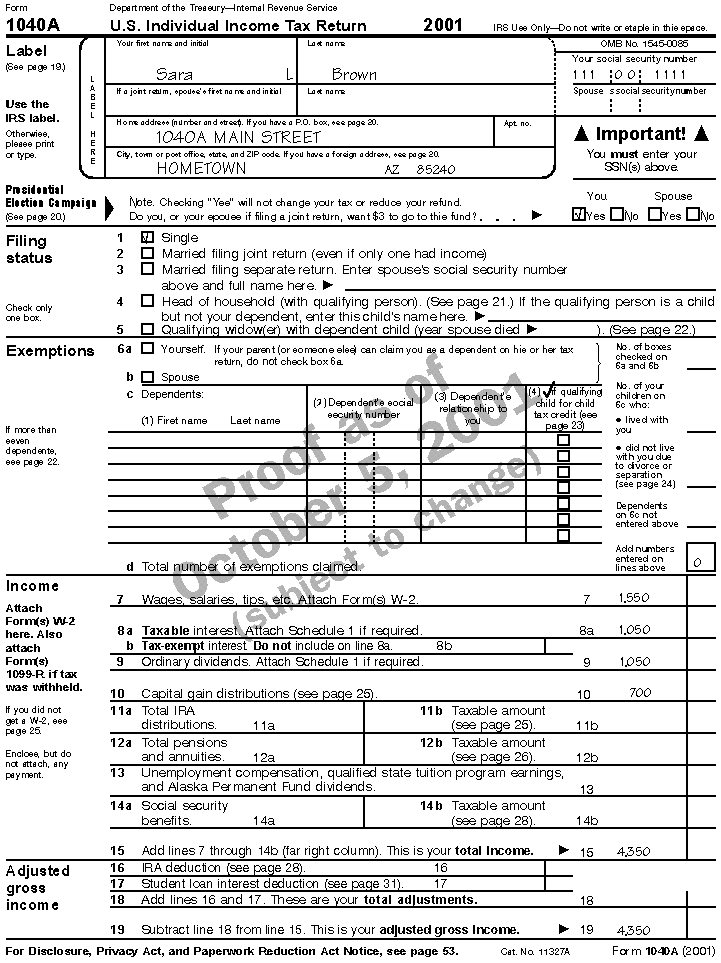
Form 1040A, page 1, for Sara L. Brown
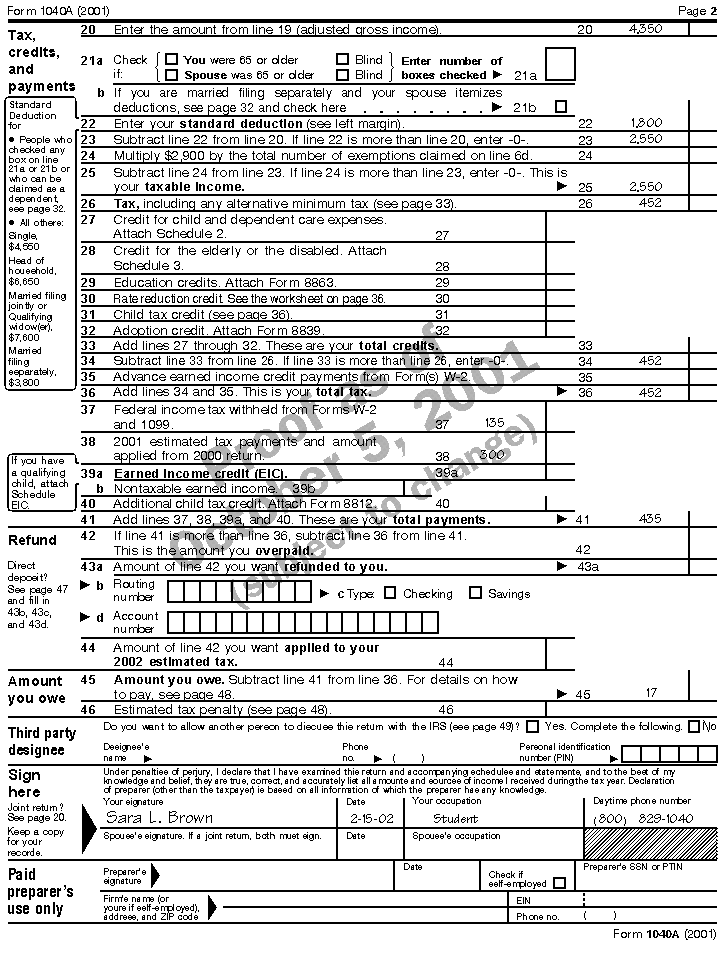
Form 1040A, page 2, for Sara L. Brown
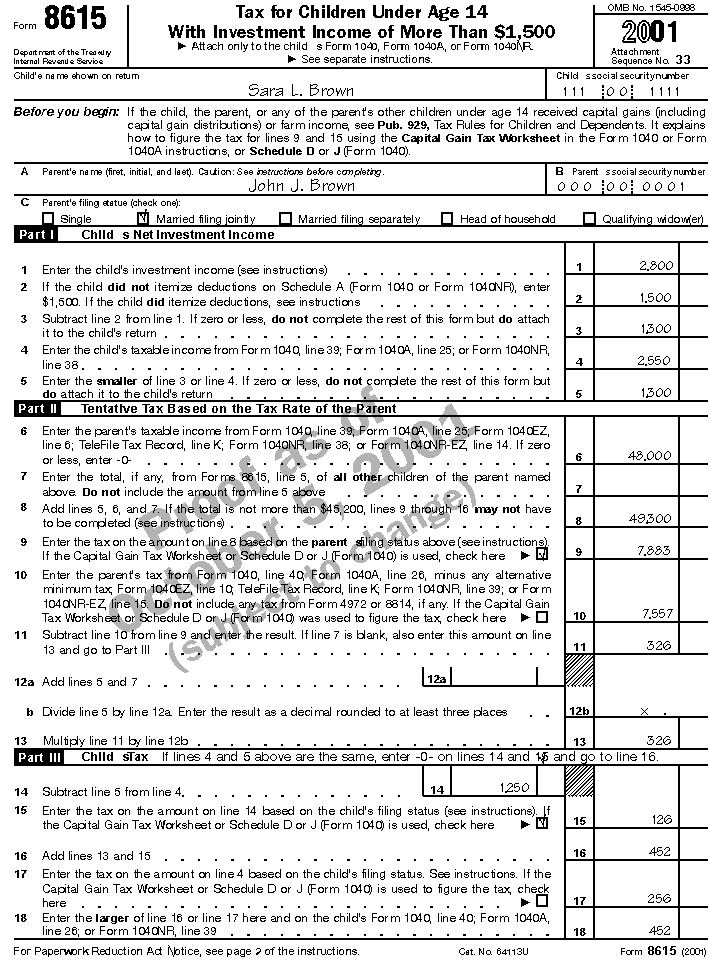
Form 8615 for Sara L. Brown
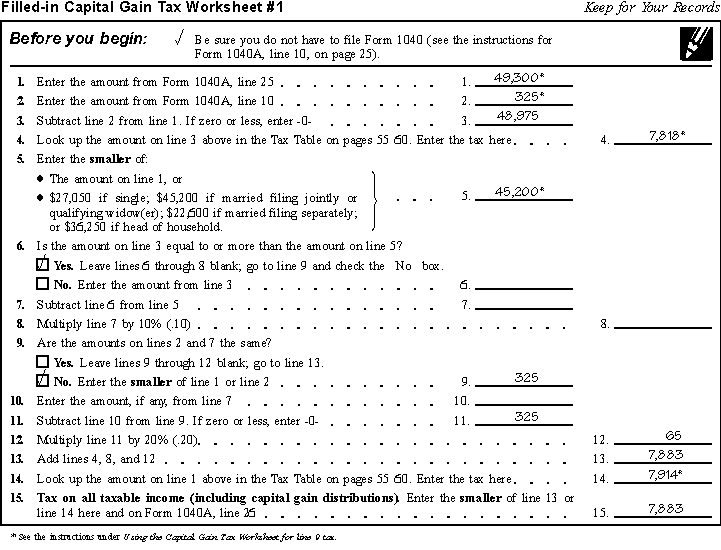
Filled-in Capital Gain Tax Worksheet #1 (showing 7,084
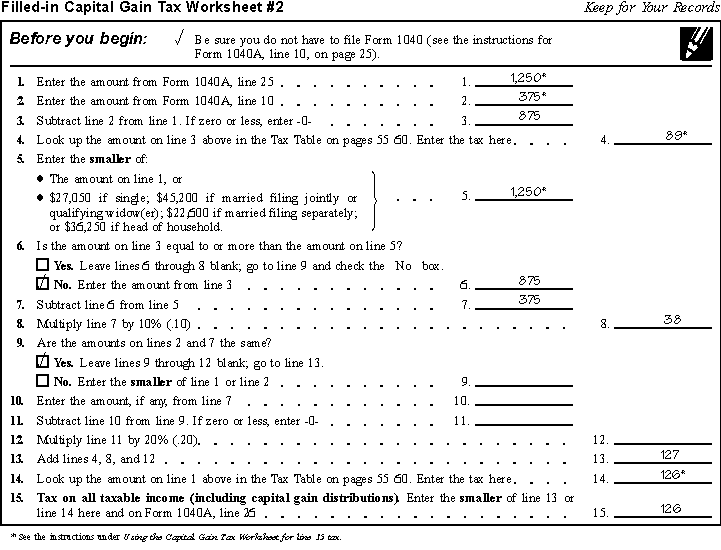
Filled-in Capital Gain Tax Worksheet #2 (showing 126)
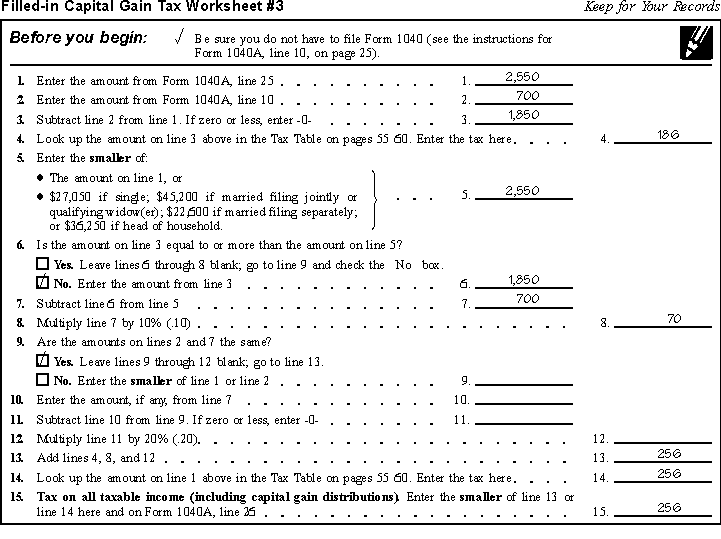
Filled-in Capital Gain Tax Worksheet #3 (showing 256)
Adjusted gross income.
Gross income (defined later) minus adjustments to income (defined next).
Adjustments to income.
Deductions that are subtracted from gross income in figuring adjusted gross income. They include deductions for moving expenses, alimony paid, a
penalty on early withdrawal of savings, and contributions to an individual retirement arrangement (IRA). Adjustments to income can be taken even if
itemized deductions (defined later) are not claimed.
Alternative minimum tax.
A tax designed to collect at least a minimum amount of tax from taxpayers who benefit from the tax laws that give special treatment to certain
kinds of income and allow deductions and credits for certain kinds of expenses.
Capital gain distribution.
An allocated amount paid to, or treated as paid to, a shareholder by a mutual fund, regulated investment company, or real estate investment trust
from its net realized long-term capital gains. This amount is in addition to any ordinary dividend paid to the shareholder. You will receive a
statement from the payer if this applies to you.
Dependent.
A person, other than the taxpayer or the taxpayer's spouse, for whom an exemption (defined later) can be claimed. You can generally claim an
exemption for a dependent if the dependent:
- Lives with or is related to you,
- Is a U.S. citizen, a U.S. resident, or a resident of Canada or Mexico,
- Does not file a joint return,
- Does not have $3,000 or more of gross (total) income (does not apply to your child if under age 19 or a student under age 24),
and
- Is supported (generally more than 50%) by you.
For more information, see Exemptions for Dependents in Publication 501.
Earned income.
Salaries, wages, tips, professional fees, and other amounts received as pay for work actually done.
For purposes of determining a dependent's standard deduction, earned income also includes any part of a scholarship or fellowship grant that the
dependent must include in his or her gross income.
Exemption.
An amount ($3,000 for 2002) that can be subtracted from income in figuring how much income will be taxed. Exemptions generally are allowed for the
taxpayer, the taxpayer's spouse, and qualifying dependents.
Gross income.
All income from all sources (other than tax-exempt income) that must be included on your tax return.
Investment income.
See Unearned income, later, and Investment income defined, earlier, under Step 1. Figuring the Child's Net Investment
Income (Form 8615, Part I).
Itemized deductions.
Deductions allowed on Schedule A (Form 1040) for medical and dental expenses, taxes, interest, charitable contributions, casualty and theft losses,
and miscellaneous deductions. They are subtracted from adjusted gross income in figuring taxable income. Itemized deductions cannot be claimed if the
standard deduction is chosen.
Net capital gain.
The excess of net long-term capital gain over any net short-term capital loss. For 2002, this is the smaller of the gain on line 16 or the gain on
line 17 of Schedule D (Form 1040), Capital Gains and Losses. If Schedule D is not required, net capital gain is the amount of capital gain
distributions on Form 1040, line 13, or Form 1040A, line 10.
Net investment income.
The total of all investment income (other than tax-exempt income) reduced by the sum of the following: adjustments to income related to the
investment income, plus the larger of:
- $750 plus itemized deductions directly connected with producing the investment income, or
- $1,500.
Standard deduction.
An amount (based on filing status, age, and blindness) that can be subtracted from adjusted gross income in figuring taxable income. The standard
deduction of a dependent is subject to a limit based on earned income. The standard deduction is not used if itemized deductions are claimed.
Tax year.
The time period covered by a tax return. Usually this is January 1 to December 31, a calendar year, but taxpayers can elect a fiscal tax year with
different beginning and ending dates.
Taxable income.
Gross income minus any adjustments to income, any allowable exemptions, and either itemized deductions or the standard deduction.
Unearned income.
Income other than earned income. This is investment-type income and includes interest, dividends, and capital gains. Distributions of interest,
dividends, capital gains, and other unearned income from a trust are also unearned income to a beneficiary of the trust.
How To Get Tax Help
You can get help with unresolved tax issues, order free publications and forms, ask tax questions, and get more information from the IRS in several
ways. By selecting the method that is best for you, you will have quick and easy access to tax help.
Contacting your Taxpayer Advocate.
If you have attempted to deal with an IRS problem unsuccessfully, you should contact your Taxpayer Advocate.
The Taxpayer Advocate represents your interests and concerns within the IRS by protecting your rights and resolving problems that have not been
fixed through normal channels. While Taxpayer Advocates cannot change the tax law or make a technical tax decision, they can clear up problems that
resulted from previous contacts and ensure that your case is given a complete and impartial review.
To contact your Taxpayer Advocate:
- Call the Taxpayer Advocate at 1-877-777-4778.
- Call, write, or fax the Taxpayer Advocate office in your area.
- Call 1-800-829-4059 if you are a TTY/TDD user.
For more information, see Publication 1546, The Taxpayer Advocate Service of the IRS.
Free tax services.
To find out what services are available, get Publication 910, Guide to Free Tax Services. It contains a list of free tax publications
and an index of tax topics. It also describes other free tax information services, including tax education and assistance programs and a list of
TeleTax topics.
 Personal computer. With your personal computer and modem, you can access the IRS on the Internet at www.irs.gov. While
visiting our web site, you can:
Personal computer. With your personal computer and modem, you can access the IRS on the Internet at www.irs.gov. While
visiting our web site, you can:
- See answers to frequently asked tax questions or request help by e-mail.
- Download forms and publications or search for forms and publications by topic or keyword.
- Order IRS products on-line.
- View forms that may be filled in electronically, print the completed form, and then save the form for recordkeeping.
- View Internal Revenue Bulletins published in the last few years.
- Search regulations and the Internal Revenue Code.
- Receive our electronic newsletters on hot tax issues and news.
- Learn about the benefits of filing electronically (IRS e-file).
- Get information on starting and operating a small business.
You can also reach us with your computer using File Transfer Protocol at ftp.irs.gov.
 TaxFax Service. Using the phone attached to your fax machine, you can receive forms and instructions by calling
703-368-9694. Follow the directions from the prompts. When you order forms, enter the catalog number for the form you need. The
items you request will be faxed to you.
TaxFax Service. Using the phone attached to your fax machine, you can receive forms and instructions by calling
703-368-9694. Follow the directions from the prompts. When you order forms, enter the catalog number for the form you need. The
items you request will be faxed to you.
For help with transmission problems, call the FedWorld Help Desk at 703-487-4608.
 Phone. Many services are available by phone.
Phone. Many services are available by phone.
- Ordering forms, instructions, and publications. Call 1-800-829-3676 to order current and prior year
forms, instructions, and publications.
- Asking tax questions. Call the IRS with your tax questions at 1-800-829-1040.
- Solving problems. Take advantage of Everyday Tax Solutions service by calling your local IRS office to set up an in-person
appointment at your convenience. Check your local directory assistance or www.irs.gov for the numbers.
- TTY/TDD equipment. If you have access to TTY/TDD equipment, call 1-800-829- 4059 to ask tax
questions or to order forms and publications.
- TeleTax topics. Call 1-800-829-4477 to listen to pre-recorded messages covering various tax
topics.
Evaluating the quality of our telephone services. To ensure that IRS representatives give accurate, courteous, and professional answers,
we use several methods to evaluate the quality of our telephone services. One method is for a second IRS representative to sometimes listen in on or
record telephone calls. Another is to ask some callers to complete a short survey at the end of the call.
 Walk-in. Many products and services are available on a walk-in basis.
Walk-in. Many products and services are available on a walk-in basis.
- Products. You can walk in to many post offices, libraries, and IRS offices to pick up certain forms, instructions, and
publications. Some IRS offices, libraries, grocery stores, copy centers, city and county governments, credit unions, and office supply stores have an
extensive collection of products available to print from a CD-ROM or photocopy from reproducible proofs. Also, some IRS offices and libraries have the
Internal Revenue Code, regulations, Internal Revenue Bulletins, and Cumulative Bulletins available for research purposes.
- Services. You can walk in to your local IRS office to ask tax questions or get help with a tax problem. Now you can set up an
appointment by calling your local IRS office number and, at the prompt, leaving a message requesting Everyday Tax Solutions help. A representative
will call you back within 2 business days to schedule an in-person appointment at your convenience.
 Mail. You can send your order for forms, instructions, and publications to the Distribution Center nearest to you and receive a response
within 10 workdays after your request is received. Find the address that applies to your part of the country.
Mail. You can send your order for forms, instructions, and publications to the Distribution Center nearest to you and receive a response
within 10 workdays after your request is received. Find the address that applies to your part of the country.
- Western part of U.S.:
Western Area Distribution Center
Rancho Cordova, CA 95743-0001
- Central part of U.S.:
Central Area Distribution Center
P.O. Box 8903
Bloomington, IL 61702-8903
- Eastern part of U.S. and foreign addresses:
Eastern Area Distribution Center
P.O. Box 85074
Richmond, VA 23261-5074
 CD-ROM for tax products. You can order IRS Publication 1796, Federal Tax Products on CD-ROM, and obtain:
CD-ROM for tax products. You can order IRS Publication 1796, Federal Tax Products on CD-ROM, and obtain:
- Current tax forms, instructions, and publications.
- Prior-year tax forms and instructions.
- Popular tax forms that may be filled in electronically, printed out for submission, and saved for recordkeeping.
- Internal Revenue Bulletins.
The CD-ROM can be purchased from National Technical Information Service (NTIS) by calling 1-877-233-6767 or on the
Internet at http://www.irs.gov/cdorders. The first release is available in early January and the final release is available in late
February.
 CD-ROM for small businesses. IRS Publication 3207, Small Business Resource Guide, is a must for every small business owner or
any taxpayer about to start a business. This handy, interactive CD contains all the business tax forms, instructions and publications needed to
successfully manage a business. In addition, the CD provides an abundance of other helpful information, such as how to prepare a business plan,
finding financing for your business, and much more. The design of the CD makes finding information easy and quick and incorporates file formats and
browsers that can be run on virtually any desktop or laptop computer.
CD-ROM for small businesses. IRS Publication 3207, Small Business Resource Guide, is a must for every small business owner or
any taxpayer about to start a business. This handy, interactive CD contains all the business tax forms, instructions and publications needed to
successfully manage a business. In addition, the CD provides an abundance of other helpful information, such as how to prepare a business plan,
finding financing for your business, and much more. The design of the CD makes finding information easy and quick and incorporates file formats and
browsers that can be run on virtually any desktop or laptop computer.
It is available in March. You can get a free copy by calling 1-800-829-3676 or by visiting the website at
www.irs.gov/smallbiz.
Previous | First
Publication Index | 2002 Tax Help Archives | Tax Help Archives | Home
